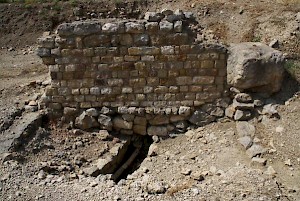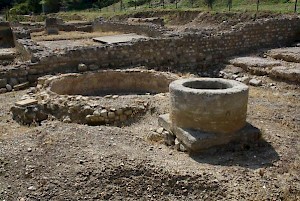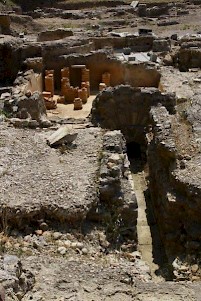Narbonne - Le Clos de la Lombarde
Narbo Martius: important Roman city in Roman France, capital of Gallia Narbonensis, modern Narbonne.

Although Narbonne, ancient Narbo Martius, in southern France was one of the most important Roman colonies in Gaul, not many remains of the ancient city have survived. Only some traces of the Via Domitia, several underground warehouses (horrea), parts of the city wall, and the site of Le Clos de la Lombarde document Narbonne's Roman past.
Excavation of Le Clos de la Lombarde started in 1973, and soon offered a wealth of information about an aristocratic part of the city in Late Antiquity. The archaeologists discovered the foundations of houses, workshops, and a bathhouse. Later, the remains of a Christian basilica and a cemetery were found as well. Today, a visit to the site is a nice addition to seeing the mosaics and paintings, originally found here, in the archaeological museum of Narbonne.

Archaeological research has shown that the area was occupied from the end of the Roman Republic until the fifth century of our era. Le Clos de la Lombarde consisted of a large residential quarter with different streets with the same orientation. Some of the streets were flanked by porticos, which were wide enough to do business and build small shops. The artisans must have done their work in the adjacent houses.
One of the porticos was investigated. It measured about 90x24 meters. Water conduits and drains appear to have been created quite early; traces of the canals and the lead pipes are still visible.
During the investigation of House IV, beautiful marble floors and paintings were discovered, which are now visible in the archaeological museum. One of the most impressive works of art is a fresco that shows Phaeton, the son of the Sun God, in the chariot of his father.

The House with the Large Triclinium has a surface of 705 square meters, and has completely been excavated. It is a typical aristocratic mansion from the second century, consisting of several units. Three had access to the garden, one was directed to the street. A room with a surface of 90 square meters has been identified as the triclinium (dining hall). Again, there were nice wall paintings and a floor covered with multicolored marble.
The House of the Genius dates back to the first century BCE and has a surface of 975 square meters. It is discussed here.
At the end of the excation site, the remains were discovered of a bathhouse, which can be dated to the first century CE. Covering a surface of about 700 square meters, it was built on top of the old artisans' quarter. The bathhouse received water from two wells and a system of conduits made of lead. Several parts of the building were decorated with painted stucco, statues, and marble floors. This was a very luxurious complex.
In the course of the third century, the mansions were abandoned, and in the fourth century, a church was built on top of the old houses. It is discussed here.